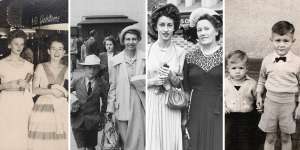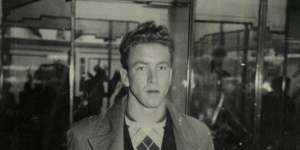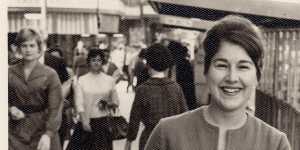Don’t get me wrong:I don’t bow to the decrees of the Queer Eye/Project Runway/Trinny and Susannah style council. But when I go into a city aspiring to strut its stuff on the world stage I expect residents and visitors to have checked themselves in the mirror between getting out of bed and walking down the Hay Street Mall.

Dressed up to head into Perth:Pat Carlene and Janet;Bob and Gwen Maughan;Fay and mother Mena Whittome;Stephen and Neil Wilson.Courtesy Joan Carney,Catherine Maughan,Bruce Hoar,Neil Wilson.
These sartorial shockers sent me back to my family photo album,which is bursting at the seams with images of my fashion-plate father Enrikas and his future wife,one-time Betts and Betts saleswoman Mary,who looked like they stepped straight out of an episode ofMad Men orThe Marvelous Mrs Maisel.
So you imagine my delight when I discovered an entire exhibition devoted to street photography during the month-long that celebrates Perth’s penchant for “going to town” dressed to the nines,even if it was just to visit the Boans butter mountain.
“There were no suburban shopping centres,so people would come into the city to buy everything. They would go to butchers and bakers,to department stores,to doctors and dentists,to pay bills,to buy fancy clothes,” saysGoing to Town curator Wendy Lugg of History West.

The author’s father,Enrikas Naglazas.Supplied
“And when they came into the city they dressed up. For women,it was hats,handbags and gloves,for men it was jackets and sleeveless pullovers.
“People dressed smartly. And this lasted into the 1960s and 70s when there was a major social and cultural change.”
We know that our parents and grandparents dressed like Cary Grant and Kate Hepburn just to buy a pound of bacon or a vacuum cleaner or to get their shoes mended because they were captured by an army of street photographers who operated in the centre of the city from the 1930s to the 1980s (around 30 at their peak in the 1940s and 50s) and beautifully showcased in the Town Hall exhibit.
These candid cameramen and women,as they were called,would shoot passersby,hand them a ticket and the film would be rushed to a developing studio. If the subjects wanted a copy of the photo,they would go to a photo booth,look at a proof sheet and buy the photo they wanted (often during the same visit to the city).
“Cameras and photography were expensive during that period. And if a family took some photos they would often sit in the camera for a year until the roll of film was finished,” says Lugg.
“So the street photographers offered something more immediate. I guess they were selfies of the day.
“And then there were the families who wanted a record of their children growing up. While most of the images are of people in motion,it’s pretty clear from the snaps we have from the 1950s and 60s families tracked down street photographers in Forrest Place or near the Commonwealth Bank in Murray Street and posed for photos.”
While it seems innocent enough,the practice caused a major fuss,with the professional photographic studios leaning on the council to stop the candid cameramen and women from plying their trade.

Christine Morgan,1962.Courtesy Chris Foulkes-Taylor
“The owner of one of the developing studios,Acme Print,argued that the street photographers should be allowed to practice even though they didn’t pay rates because each one created seven other jobs,from the runners who transported the negatives to the people developing the negatives and doing the printing,” says Lugg.
It also provided employment for returned servicemen after World War II,who were assisted by the government to work as street photographers,many of whom later worked forThe West Australian.
One inspiration for the exhibition is to showcase the changing nature of the city – which can be seen in the background of many of the photos – and to celebrate a time when coming into the CBD was something special.
Sadly,the exhibition also highlights what is not there,namely Western Australia’s First Nations population. Despite their best efforts,Lugg could only find a single photograph of First Nations folks — Jimmy Poland and his sister Ivy Mallard — because they needed a permit to travel into the Perth Prohibited Zone and were banned from entering the city after 6pm.
Indeed,the exhibition overall is very Anglo-Celtic,despite the huge influx of migrants into the state pre and post-World War II.
Lugg and History West are keen to capture the diversity of the street photography era,so if anyone wants to offer up their family snaps to this ongoing social history project you can contact the team at.
Lugg is especially keen to make contact with street photographers of the time or a member of their families.
Despite her best efforts,Lugg is yet to find one of these mythical men or women who were such a vibrant part of the mid-century Perth landscape and is anxious to give them their place in history.
Going to Town is during April on at the Perth Town Hall 10am to 4pm. And in Trinity Arcade there is a related display of hats and other finery of the era and exhibition of fabrics and garments inspired byGoing to Town from North Metropolitan TAFE fashion students. It’s all free.
Get the day’s breaking news,entertainment ideas and a long read to enjoy.